November 20, 1925 – June 6, 1968

A lot of people think Americans have an exaggerated sense of self-importance. When I moved to England, it was a real eye opener for me to realize that Americans are not embraced all around the world. It’s just as shocking that some people honestly thought September 11th came out of nowhere. However, the assassination of Robert F. Kennedy is one event that truly changed the world. For one, it is quite likely that Kennedy would have become president, but instead we got Nixon. Makes you wonder.
The movie Bobby was one of the last films that used the Ambassador before it’s demolition – and has become one of my favorites. Plus, it’s the first time in about 10 years that Sharon Stone and Demi Moore weren’t embarrassing. If you love the sixties and are fascinated by the assassination – get this movie. Seriously.
RFK was the younger brother of President John F. Kennedy, and a senator of New York. There is plenty of info on him and his political career, Marilyn, Hoover, etc. elsewhere. I had a hard time just whittling this info together, you could go on for hours on the net.
On June 4th, 1968, Kennedy was at the Ambassador Hotel in Los Angeles. He and his wife Ethel were there to celebrate his winning the presidential primary for California. They no doubt would have driven up this driveway

and entered the hotel from the famous doors

below this great clock,
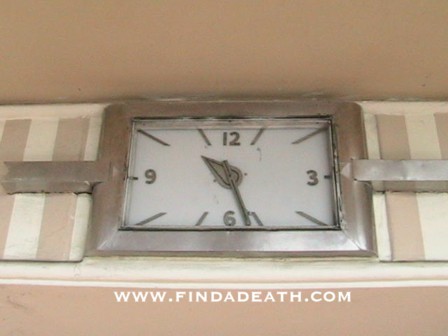
and over the plush red carpet.
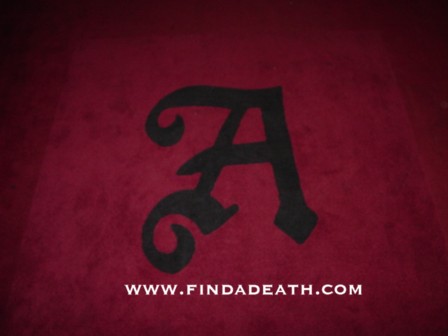
They may have snacked in the coffee shop,


or just strolled past the elevators

past the lobby

and front desk.

Or maybe they got real nosey like me and snuck behind the front desk to peek in the office and got yelled at by security.

From California, RFK would go on to Chicago for the next lap of the primaries. With Kennedy was football star Roosevelt “Rosey” Grier,

along with Decathlon champ Rafer Johnson.
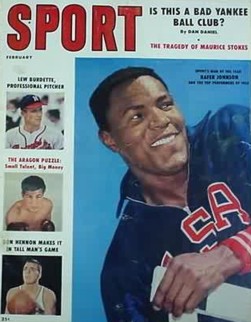
Also in attendance was singer Rosemary Clooney.
My sources state that Bobby was staying in the Sportsman’s Lodge, on Ventura Boulevard in the Valley.


My good buddy Jayne tells me, “The Sportsman’s Lodge used to be a haven for famous people because no one thought to look for them there.” I understand that RFK had the entire 5th floor (poolside) for himself and family, but based his political headquarters in The Ambassador. There is one rumor that Sirhan Sirhan came into The Sportsman’s Lodge and took the elevator up to the 5th floor to where the Kennedy family was staying, but security wouldn’t let him get off the elevator. Good Goss Jayne, Thanks.
The Kennedy base was the Royal Suite in the Ambassador, and confident they cinched the Democratic primary, they headed down the service elevator through the kitchen, and into the Embassy Room.

Bobby was wearing a dark blue suit coat with the label Georgetown University Shop – Georgetown, D.C. Matching trousers, a brown leather belt (32″ waist) and the zipper was intact. Hear that, Marilyn? His white cotton shirt with the label K. Wragge, 48 W. 46th St. NY and the laundry maker initials RFK on the neckband. A navy blue silk tie with gray stripe, and plain oval cufflinks.
At 11:30 p.m., Kennedy, Ethel (pregnant with their 11th child), and his entourage entered the ballroom. Addressing the gathered crowd from this stage, he thanked them for their support, and talked about the assassination of Martin Luther King and the war in Vietnam.
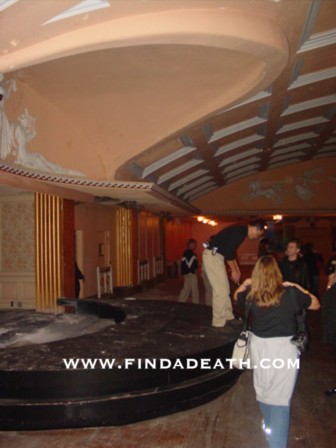
Then, flashing the victory sign, he said, “It’s on to Chicago, and let’s win there!” He and the rest of the group left the Ballroom through a door in the back of the stage,

which took them through the pantry

to the kitchen area, where the kitchen staff waited to meet RFK.


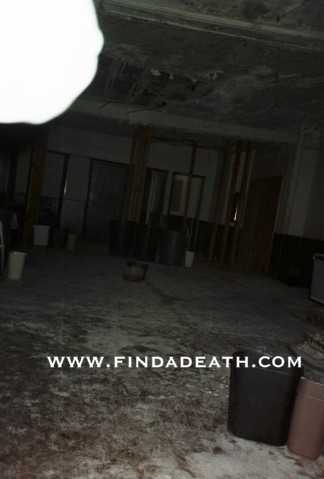
(By the way, we were strictly forbidden to photograph the pantry. Psh.)
Inside, Kennedy greeted the waiters and busboys. Bobby was speaking with a busboy named Juan Romero, when Sirhan Bishara Sirhan emerged just a few inches from Kennedy, yelling, “Kennedy, you son of a bitch!” Just then, shots rang out. Kennedy sank to the floor right here, seriously wounded.

Brandon writes, “After being shot, it is widely accepted that RFK’s last words were, “Is everyone all right?”

This was caught on tape by reporter Andrew West from KRKD-AM in Los Angeles.
Juan Romero put a rosary in his hand. Ethel came tearing though the crowd and yelled, “Get back all of you! For God’s sake, give him room to breathe.” A page went over the loudspeaker for a doctor, and Doctor Stanley Abo was on the scene, discovering a bullet hole behind Kennedy’s head, below his left ear. He then attempted to stimulate blood flow. It was now June 5th, 12:15 a.m. Kennedy was taken to the service elevator

and then rushed by ambulance to Central Receiving Hospital.

This hospital has been destroyed in 2007.

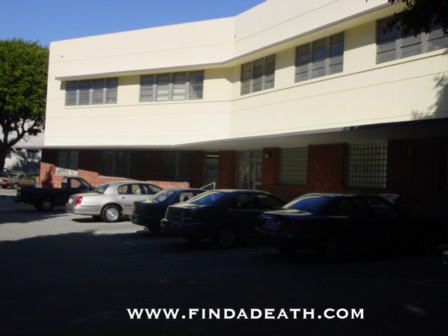
Doctors there discovered powder burns around the wound, which meant the shot was fired at very close range. Because there was no neurosurgeon on hand, within 30 minutes Kennedy was sent to the Good Samaritan Hospital.

Doctors at Good Samaritan uncovered two more wounds on Kennedy – one in the right armpit and another several inches down. Kennedy then underwent surgery, which lasted three hours and forty minutes. During this operation, surgeons removed a blood clot that had re-formed behind the brain, and as many “fragments of metal and bone as they could, according to Kennedy’s aides. By 5 p.m., his condition was extremely critical. Crowds had gathered outside the hospital.
In the room with him were his brother, Teddy, wife, Ethel, Jackie Kennedy, sisters Jean Smith, Pat Lawford, and three of his ten children (the others were in another room). At 1:44 a.m. on June 6th, Kennedy died.
He was 42 years old.

What I find really interesting is that Kennedy didn’t die immediately, as I always thought. He lived for another day, and was even transferred to a second hospital. Just a different take on the history I thought I knew.
Find a Death friend Michelle sends this picture of Sirhan Sirhan being arrested.

He was a Jerusalem immigrant with an apparently strong hatred (no shit) for RFK. He was reportedly seen at previous Kennedy events, including a speech on June 2nd. According to reports, he was a loner with a big fondness for horse racing.
Sirhan was living in this house in Pasadena, and it was here that the FBI found his notebooks with insane scrawls about Kennedy in them.


Thanks to Keith Hunt for the info, and my buddy Steve Goldstein for the photographs. Sirhan was taken to the Rampart Street police station, but moved quickly out of fear of vigilante justice. It wasn’t until after they moved him, that the police learned his name.

Enter Dr. Thomas Noguchi, coroner to the stars (and my personal hero), the man who performed autopsies on Marilyn Monroe, John Belushi, Nick Adams, and Natalie Wood, to name a few. He began the dissection of Bobby at 3 a.m. According to the report, “Inspection of the head and removal of the brain, spinal cord and temporor-occipital bone began at 7:40 a.m. in the autopsy room of the Hospital of the Good Samaritan. At 4 p.m., after six hours of preliminary fixation, the brain was cut in six coronal sections and examined. According to Noguchi, four bullets had been fired at Kennedy, and the fatal one had been fired at a range of one and a half inches. However, the fatal shot entered the back of his neck, fragmented upon impact and lodged in his brain stem. All witnesses had stated that Sirhan had fired from the front of Kennedy, and Kennedy had never had his back to Sirhan. Thus, the possibility of a second gunman was born. In his book, “Coroner”, Noguchi states, “Until more is precisely known, the existence of a second gunman remains a possibility. Thus, I have never said that Sirhan Sirhan killed Robert Kennedy.”
Bobby’s body was flown back to New York for a funeral on June 8th at St. Patrick’s Cathedral. Teddy eulogized his third dead brother (the first died in a plane crash) by saying,
“My brother need not be idealized, or enlarged in death beyond what he was in life, to be remembered simply as a good decent man, who saw wrong and tried to right it, saw suffering and tried to heal it, saw war and tried to stop it.
Those of us, who loved him and who take him to his rest today pray that what he was to us and what he wished for others will someday come to pass for all the world.
As he said many times, in many parts of this nation, to those he touched and who sought to touch him: ‘Some men see things as they are and say, “Why?” I dream things that never were and say, Why not?”
Bobby was then taken by train back to DC for burial.
Kelly sends in: There were 2 people killed on the route of RFK’s funeral train–they stepped onto the tracks to wave to the train, I think, and were killed by a train going the other direction. Here’s an article from theWashington Post that talks about it.
Twenty-three limousines, a bus for the media, and the hearse containing Bobby wound their way through the streets of Washington DC, all the way to Arlington, to be buried just a few yards from his brother JFK.

They dedicated the strip of Wilshire Boulevard in front of the Ambassador to RFK.

The hotel itself, is due to be demolished soon. There are feeble attempts to preserve it, but it looks likely to become a school soon, though I understand they will be preserving the ceiling of the Embassy Room, the Cocoanut Grove, the front entrance and coffee shop. The jury is out about the pantry, though this is my bit.
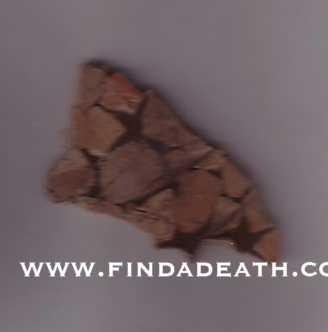
I also grabbed about 10 pounds of crap from the floor of the Embassy Room.

I love Diane Keaton’s argument, “Students could read The Great Gatsby in the same place its author frequented, perform in the Cocoanut Grove where stars like Frank Sinatra and Bing Crosby and that horrible Streisand
woman (kidding) played, and study history where every president from Herbert Hoover to Nixon stayed, the latter having written his famed Checkers speech there in 1952. They could also walk in Robert Kennedy’s final footsteps.”
Sirhan has been up for parole several times. We have Michelle Seglem to thank for this recent article and photograph on the man.
Meg the Find a Death friend and all around Death Hag sends us this in May of 2009: I was living in San Francisco in 1978 when Dan White assassinated both Mayor George Moscone and Supervisor Harvey Milk (now immortalized in film by Sean Penn). As you probably know, White was convicted for voluntary manslaughter (for 2 deaths!!) and sentenced to five to seven years in Soledad prison. While there, he was kept in the protective unit (of course). The prisoners in the protective unit were only allowed out into the yard when the GP prisoners weren’t there. White liked to run the running track and when he first got there, only one other prisoner from the protective unit would run at the same time as White. It turns out the prisoner was Sirhan Sirhan. White introduced himself and the assassins soon became great prison buddies. White was reportedly proud of the friendship and bragged about it. Whatever.
White was released in 1984 and ended up committing suicide in 1985 (via carbon monoxide) while of course Sirhan is still behind bars. Talk about birds of a feather etc.! I heard/read this story years ago as related by Mike Weiss, a political writer from San Fran.
While meandering through the hotel, we were able to check out the legendary Cocoanut Grove.

On the outside, there still is a tatty sign from the 1970’s,
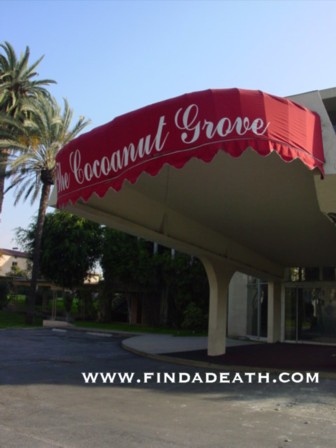
and the larger one outside over the driveway.

Though not as glamorous as it was in its heyday, just knowing the history that happened there, made it a very special experience.

I even went backstage (before I was yelled at), where several Oscar winners were escorted after winning trophies in the Grove.

Silliness: According to one biography, Kennedy had affairs with Jayne Mansfield, Marilyn, Jackie Kennedy, Barbara (Marx) Sinatra, Candice Bergen, and Rudoph Nureyev. Yes. In a phone booth, no less.
Did you ever wonder what the Ambassador Hotel would look like if there were amusement park set up in front of it? Yeah, I thought so.

My pal Bob reminds me that Bobby had dinner with Sharon Tate and Roman Polanski, the evening before he was shot.
Find a Death pal Bob sends this: Bobby’s will clearly states he wanted to be buried on the Kennedy compound in Hyannis Port, Mass. But his wife Eiffel had different ideas. How she was able to disregard his will, I do not know. I guess if you’ve got the money of a Kennedy you can get away with anything. Eiffel got Bobby buried in Arlington National Cemetery. She has basically made a career out of being the wife of his corpse. Wow, fascinating. Thanks Bob.
Several people have emailed me about the book, Nemesis. Findadeath friend Jon sends me this: Thought you might be interested in this re: your RFK addition. According to the new book “Nemesis” by Peter Evans, Christina Onassis confessed that Onassis had RFK killed. This stuff below is actually taken from the “Gemstone Chronologies” — the debunked work of a paranoid schizophrenic, but it – could be …
June 17, 1968: Bobby Kennedy knew who killed his brother; he wrote about it in his unpublished book, The Enemy Within. When he foolishly tried to run for President, Onassis had him offed using a sophisticated new technique: hypnotized Sirhan Sirhan shooting from the front, “security guard” (from Lockheed Aircraft) Thane Cesar shooting from two or three inches away from Bobby’s head – from the rear. Sirhan’s shots all missed; Cesar’s couldn’t possibly miss. Evelle Younger, then the L.A. D.A., covered it all up, including the squawks of L.A. Coroner Thomas Noguchi; Younger was rewarded with the post of California Attorney General later. His son, Eric Younger, got a second-generation Mafia reward: a judgeship at age 30. (See Ted Charach, L.A., author and director, The Second Gun, a documentary film on the RFK murder, bought and suppressed by Warner Brothers, for more details.) After Bobby’s death, Teddy knew who did it. He ran to Onassis, afraid for his life, and swore eternal obedience. In return, Onassis granted him his life and said he could be President, too, just like his big brother, if he would just behave himself and follow orders.
Bobby was a veteran of the Navy.
Thanks to Kevin Hassell for getting me off my fat ass to do this, Steve Goldstein for accompanying me to the Ambassador, and for some great pictures. Big kudos to the folks Celebrity Collectables, who sent me Bobby’s rather lengthy autopsy report. This document is fascinating. Complete with gun ballistic tests, clothing reports, tissue tests, reports of photography- really interesting. The perfect birthday gift.
Say goodbye to the Ambassador Hotel 8-31-05:

As President of the Los Angeles Conservancy, I wanted to share with you my thoughts on the end of the Conservancy’s long effort to preserve Wilshire Boulevard’s Ambassador Hotel – one of Los Angeles’ defining historic sites.
I am very sad to report that we have fought the good fight, but have lost. Demolition of the Ambassador Hotel will likely begin within the coming months. But this effort has allowed us to create a breakthrough agreement with LAUSD that will help preserve dozens of other historic schools throughout Los Angeles.
In July, we were tremendously disappointed when a Superior Court judge denied a lawsuit by the Conservancy and seven other plaintiffs to block demolition of the Ambassador. Following this setback, our organizations decided not to file a final, long-shot legal appeal. We came to this decision after considerable deliberation and with great sadness because we remain convinced that the Ambassador site represents a tragic missed opportunity for LAUSD, L.A.’s kids, and all Angelenos. LAUSD could have feasibly created a school campus that treated the rich history of the Ambassador as an asset, not as an obstacle. Yet, after years of tremendous effort on this issue, we have exhausted all of our realistic options.
Our fight to preserve the Ambassador Hotel was never just about saving bricks and mortar, or about sentimentally commemorating the Ambassador’s past. It has always been about looking forward – about using history to build a better school for our kids, and a better community. The Conservancy is about preserving and revitalizing Los Angeles’ heritage for our kids, the kids who will grow up to make this heritage their own. and we have tried to live by these ideals in handling the final chapters of the Ambassador saga.
With the handwriting truly on the wall, we have therefore tried to make the best of a disheartening situation. W e have obtained a binding commitment from the Los Angeles Unified School District (LAUSD) to create a permanent non-profit endowment to preserve and revitalize its most historic school campuses for Los Angeles’ next generations.
From the day LAUSD acquired the Ambassador, the Conservancy and its partners have stated clearly that we supported a school at the site. There is a desperate need for school facilities in this neighborhood, with thousands of kids being bused for hours each day to distant campuses. Beginning in 2001, the Conservancy and a talented pro bono team of top professional preservation architects and engineers, led by Conservancy Board Members Barry Milofsky and Nabih Youssef, created a workable plan that would have allowed L.A.’s kids to go to school in an inspiring historic setting. We will always be grateful for the incredible advocacy of thousands of Conservancy members, along with 80 leading community organizations, who joined our broad-based coalition to fight for this vision of adaptively reusing the Ambassador as a school. But LAUSD steadfastly ignored these voices: last October, on a 4-3 vote, the Board of Education turned down the adaptive reuse plan and voted to demolish almost all of the Ambassador Hotel.
After careful consideration in November, the Conservancy filed a lawsuit, joined by seven other plaintiffs – the Latino Urban Forum; Mexican American Political Association, Los Angeles Chapter; California Preservation Foundation; Art Deco Society of Los Angeles; Hollywood Heritage; Historic Preservation Overlay Zone (HPOZ) Alliance; and Korean Culture Center. Our goal was to use this litigation as an opportunity to craft a new and creative compromise alternative for the Ambassador site. And we did just that. Superintendent Roy Romer has had before him a plan that would meet everyone’s needs on the Ambassador site – a plan designed by Stan Eckstut, a nationally renowned architect of urban schools, that would have built all-new school facilities for 4,240 students on 18 acres of the site.
Under this plan, LAUSD would have sold off the main building of the Ambassador to Hollywood Community Housing Corporation, one of our city’s most successful developers of affordable housing, which wanted to create 165 housing units on floors 2-5 of the hotel. The building’s public spaces would have become a community center, with after-school programs, ESL classes, and literacy and job training programs. LAUSD would not have had responsibility to pay a single dime for historic preservation. This plan would have constructed the same 4,240 student seats as proposed by LAUSD, but in smaller, more child-friendly “Small Learning Communities” of no more than 400 seats each. It would have met LAUSD’s open space requirements, and saved LAUSD over $20 million in construction costs.
But instead of embracing this compromise, Superintendent Romer refused to change his position, even after top California elected officials urged the Superintendent to consider the plan. We remain convinced that LAUSD’s plan is the wrong plan for L.A.’s kids, and the wrong plan for our city. But, unfortunately, a Superior Court judge has ruled that LAUSD did comply with state environmental laws in approving its plan. While we continue to believe that LAUSD’s approval fell short of the requirements in state law, we also recognize that the courts tend to defer to government agencies, particularly when those agencies have prepared a full and lengthy Environmental Impact Report on a project.
Up to this point, our lawsuit has not delayed the school by a single day: LAUSD was never going to begin construction during this time period. But in looking forward toward a possible last-ditch appeal, our Board of Directors recognized that this would no longer be true. We did not want to delay the construction of school facilities for kids who are being bused for long distances, particularly when our attorneys were telling us that our chances of ultimately prevailing in court were extremely slim. And, even if we did prevail in court, the judge would have merely sent the issue back to the same LAUSD leadership, who would almost certainly just re-adopt their demolition plan for the Ambassador.
Given the significance of the Ambassador Hotel to our city’s history, the Conservancy’s Board and staff did not want to end the Ambassador fight until we became convinced that we had literally done everything possible to save this historic site. Regrettably, we came to the conclusion in recent weeks that we had, indeed, reached that point.
Faced with these sobering realities, the Conservancy’s leadership sought to create something positive, productive, and lasting out of this difficult situation, and initiated settlement discussions. Out of these discussions, LAUSD has agreed to the establishment of a new “Historic Schools Investment Fund,” which will operate as a permanent endowment and will provide grants to historic LAUSD schools for repair, restoration, and conservation of important historic features.
The $5 million fund includes $4.9 million from LAUSD and a commitment to raise an additional $100,000 by the Conservancy and other community/preservation groups. The Fund will operate as a new non-profit organization administered by a six-member Board, including representatives from LAUSD, the Conservancy, and the City of Los Angeles Cultural Heritage Commission. A 2002 historic resources survey of LAUSD campuses, also to be formally recognized by the Board of Education as part of this settlement, identified 50 LAUSD schools as eligible for listing in the National Register of Historic Places; these schools will be able to apply for grants.
Historic schools within LAUSD have serious maintenance and conservation needs – from conserving historically significant murals and repairing historic light fixtures to ensuring the historic integrity of key campus buildings. LAUSD’s construction bond funds have focused specifically on new construction and infrastructure needs, but the Historic Schools Investment Fund will be able to pay for upgrading of historic resources that will improve students’ learning environment.
Of course, this fund does not begin to compensate Los Angeles fully for LAUSD’s tragic destruction of the Ambassador Hotel. But after coming to the painful realization that we could not save the Ambassador, we have at least created a mechanism that will fund meaningful preservation at numerous historic school sites. In the end, we will be able to preserve the historic and architectural legacies of Los Angeles’ schools, and can weave these rich histories into the lives of LAUSD students.
We’d like to thank the many elected officials, including State Treasurer Phil Angelides and State Senator Gilbert Cedillo, who supported the alternative Small Learning Communities Plan. We again want to thank School Board Members David Tokofsky and Jon Lauritzen, who courageously voted last fall for adaptive reuse of the Ambassador Hotel. We also owe a tremendous debt of gratitude to the law firm of Gibson, Dunn and Crutcher, which has generously donated thousands of pro bono hours to the legal struggle to preserve the Ambassador.
But now, taking solace in the knowledge that we have done all that could be done to preserve the Ambassador, we have decided that this is the right time, and the right way, to move on. Let us draw on the lessons learned from this struggle as we re-double our efforts to preserve and revitalize Los Angeles’ heritage for our next generation.
Links
To become a member of the Conservancy, please click here.
To contribute to the Conservancy’s Preservation Advocacy Fund, please click here.
Photo Credit: Security Pacific Collection/Los Angeles Public Library
Our postal address is
523 W. 6th St. #826
Los Angeles, California 90014
United States

Our world and country would have been so much better if Bobby had been allowed to be President. If you look at the men and women assassinated on this planet, you will see it’s the progressives and the peacemakers who are targeted. People who strive to bring us out of the 5th Century and the 1950’s conditioning. In America, you are allowed to to speak, but if you start making changes to the plantation rules, and people start to listen to your message, the plantation owners WILL kill you. The plantation and slavery never ended. They simply gave the slaves the illusion that they own property and possess freedom.
I agree that he probably would have been elected to office, had he not been murdered, and things might have been better today for all of us. Him and his brother John were truly good and decent men who gave their lives for this nation. RIP.
There was no sound bite, and no photo of Sirhan.
may you rest in peace robert f kennedy